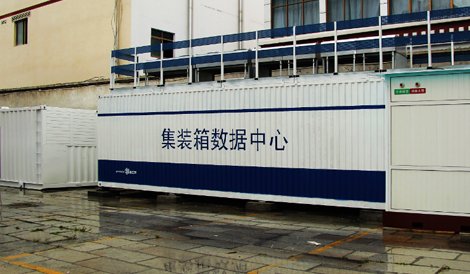C-Cube, a leading modular data center solution provider in China, recently completed a data center upgrade project for the Food and Drug Administration of Tibet (FDAT), which uses its containerized data center B Series technology. The whole project, including equipment transportation, system installation and debugging, was completed in about ten days.
The containerized data center was transported to the site by road – part of the journey covered the Qinghai-Tibet route and the Nagenla Pass, which is 5,190 m above sea level.
The data center upgrade project of FDAT is one of the key projects launched by the State Food and Drug Administration (SFDA) for enhancing the delivery and use of information for the Tibet Autonomous Region. It was created as part of China’s Twelfth Five-Year Plan Period. It is the first containerized data center deployed by the SFDA as part of its modernization goals.
FDAT’s previous data center was located within an office building, with a capacity to host only three racks. Constrained by poor space with no room to scale, the data center could hardly meet requirements for future business expansion. Adding to the problems, the two maintenance staff in charge of managing the data center and undertaking tasks for the whole Tibet region, were heavily overburdened.
But building in Tibet is not easy. The high altitude, lack of oxygen and frequent outages posed their own challenges that eventually led to SFDA choosing a modular data center solution.
About the container
C-Cube’s containerized data center B Series (B Series) is 40 inches in length. It includes most infrastructure you would find in a traditional data center, including racks, power distribution units (PDUs), Uninterruptible Power Supplies (UPS), battery, air-cooled air conditioning units, fire control systems, security systems, and monitoring systems. It can accommodate nine racks of 52U, providing a total of 468U deployment space. Each rack can provide an average of 9.2kW power capacity for IT equipment at a maximum. Working with the generator sets outside, and with the access to the electricity grid and network, the containerized data center can run smoothly as an independent data center.
Weng Yuan, general manager of C-Cube told Focus: “By using in-row cooling for shortening air delivery distance, placing single-row racks at the middle of the container for ensuring complete separation of hot and cold isles, deploying precision air conditioning systems with large air flow and high sensible heat ratio, B Series can ensure a Power Usage Effectiveness (PUE) that is lower than 1.5.”
Building in Tibet
To adapt to the actual conditions of the data center site and future business expansion requirements, C-Cube made a series of adjustments to the original configurations of the B Series while upgrading the data center for FDAT.
Weng said even though the cooling requirement of the FDAT data center is not so high now - given the limited deployment of servers and much lower rack density than designed - C-Cube installed two air conditioners with a single compressor, and two air conditioners with double compressors for the facility.
“The data center can run one or several such air conditioners in accordance with actual cooling requirements, while ensuring adequate cooling capacity when IT expansion occurs in the future, without data center restructuring for accommodating more cooling facilities,” Weng said.
C-Cube also had to take into account the data center operating conditions of Tibet. The high altitude and low oxygen ratio can lower the power efficiency of generators and lead to unstable power supply. So C-Cube selected appropriate diesel generator sets, UPSs and battery systems that can work well under such circumstances to ensure the stable and reliable power supply.
C-Cube said its B Series gives full paly to the advantages of containerized data centers. It reduces in-door space usage, simplifies on-site deployment, shortens delivery cycle and offers good scalability. “Such a containerized data center solution can be deployed in a rapid way. Installation and debugging of the whole system can be completed within two to three days,” Weng said.
The B Series provides failure alarms and fire alarms through a sound-light system outside the container. In addition, when the grid fails, the generator sets can start automatically and provide backup power within 30 seconds, and the facility will switch back to the grid once normal power supply resumes. C-Cube said all these functions also help remove work from maintenance staff.
Even more important for FDAT, which is going through its own changes, it can transport the containerized data center to a new site with ease and install it again within three days if required.

